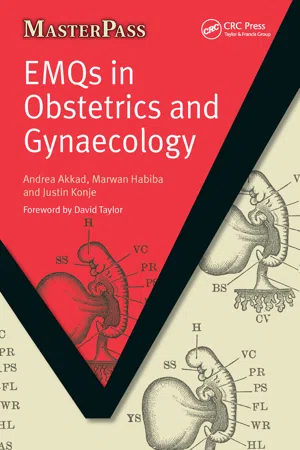
EMQs in Obstetrics and Gynaecology
Pt. 1, MCQs and Key Concepts
- 176 pages
- English
- ePUB (mobile friendly)
- Available on iOS & Android
EMQs in Obstetrics and Gynaecology
Pt. 1, MCQs and Key Concepts
About This Book
This work features a Foreword by David Taylor, Vice Dean, Leicester Medical School. "This book is the first to assist students with a new format of testing knowledge and clinical skills, i.e., the extended matching question. I am delighted my colleagues here in Leicester, where undergraduate education is given the very highest priority, have found the time and energy to write this book. This book comprehensively tests a whole range of obstetrics and gynaecology and I congratulate them for it." - David Taylor, in the Foreword. This revision aid in Obstetrics and Gynaecology is based on the Extended Matching Question format (EMQ). It contains over 200 patient vignettes arranged in topic areas covering a broad range of themes and degrees of difficulty. It provides test EMQs and detailed answers at the completion of each section. "EMQs in Obstetrics and Gynaecology" is an indispensable study and revision aid for undergraduate medical students preparing for in-course assessment in obstetrics and gynaecology as well as final exams. It also provides a vital review for specialist trainees in obstetrics and gynaecology preparing to take postgraduate exams.
Frequently asked questions
Information
EMQs in Obstetrics
1
Normal pregnancy
Theme: Physiological changes in pregnancy
Options:
A | Increase in plasma fibrinogen |
B | Reduction of renal threshold for glucose |
C | Rise in cardiac output |
D | Increase in red cell mass |
E | Increase in creatinine clearance |
F | Increase in plasma volume |
G | Delayed gastric emptying |
H | Inhibition of gonadotrophin secretion |
I | Decrease in peripheral vascular resistance |
J | Venous compression by enlarging uterus |
Lead-in:
Theme: Pregnancy milestones
Options:
A | 20-22 weeks |
B | 9 weeks |
C | 6 weeks |
D | 16 weeks |
E | 34 weeks |
F | 12 weeks |
G | 3 days post-partum |
H | 42 weeks |
I | 36-38 weeks |
J | 12 hours post-partum |
Lead-in:
Table of contents
- Cover Page
- Title Page
- Copyright Page
- Contents
- Foreword
- Preface
- About the authors
- How to answer EMQs
- Reading list
- Abbreviations
- EMQs in Obstetrics
- EMQs in Gynaecology
- Answers in Obstetrics
- Answers in Gynaecology